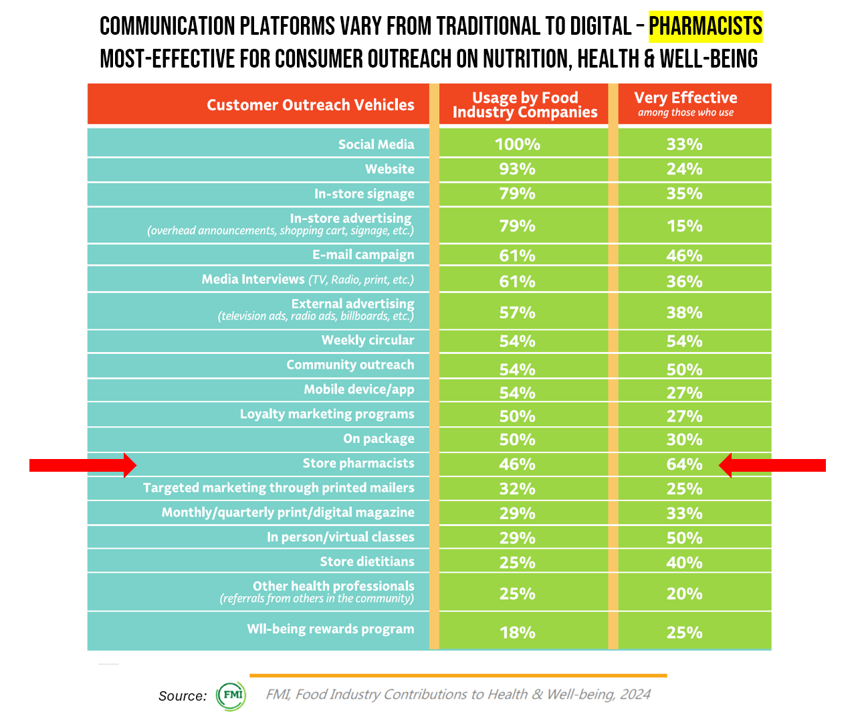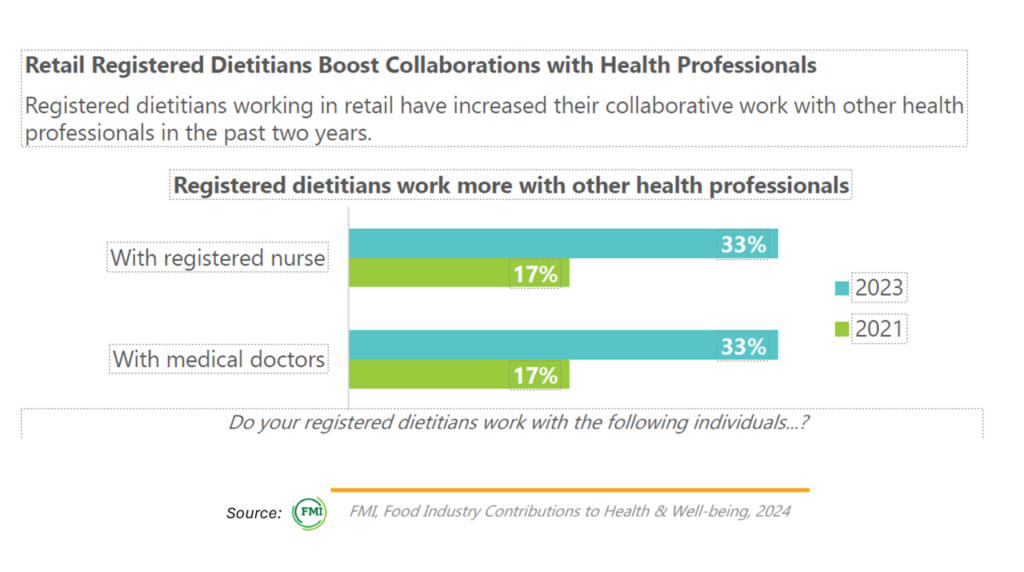The food industry, both retail food chains and food suppliers, has found health and nutrition are having a positive impact on their businesses both for margins and for missions, we learn in the latest annual survey on Food Industry Contributions to Health & Well-being, 2024, from FMI. Most retail food channels operate pharmacies, three in five operate clinics in stores, and 2 in 5 of the clinics are health system-owned and operated.

FMI, the Food Industry Association, conducted this industry poll in October 2023 among food retail and supplier members, totaling 36 organizations representing over 11,000 sites.
The study found that,
- The top focuses of food industry initiatives range from overall health to disease management and, of course, food safety strategies
- A growing community of Registered Dietitians have seats at leadership tables in food industry organizations
- Food-as-Medicine (FaM) is gaining momentum, with a growing science base and program models to help reduce disease and bolster nutrition, and,
- Food manufacturers in industry are reformulating products to address a range of health needs, at the top of list reducing sugar and sodium.

The food industry invests in a broad range of consumer outreach platforms to engaged on issues of nutrition, health, and well-being. These are traditional (like printed circulars) and digital (such as online recipe portals and email campaigns).
Of particular note for Health Populi readers is clearly marked on this chart from the report to which I added the red arrows by the pharmacist data point from FMI’s survey. In this question, food industry respondents were asked which outreach vehicle they use for communicating with consumers on nutrition, health, and well-being. Across all platforms measured, store pharmacists were cited as the most effective channel (among two-thirds of the food industry respondents) compared with weekly circulars, in-person or virtual classes, community outreach, and e-mail campaigns. 
It’s not only pharmacists who are now collaborating in retail food sites and with food manufacturers. While we’ve seen the fast growth of registered dietitians working in retail, they are increasingly collaborating with other health professionals — namely registered nurses and medical doctors. See in this chart from FMI’s 2024 study that one-third of dietitians working in retail food have collaborated with nurses and doctors, growing from 17% in 2021 to 33% in 2023. In addition, 36% of retailers in 2023 had employed registered nurses, 14% nurse practitioners, 14% medical doctors, and 7% health coaches, FMI found. 
Check out this summary slide of food industry initiatives across various health and wellness challenges; in particular, see that 38% of organizations are involved with programs for produce and food prescriptions. This is a key workflow in Food-as-Medicine programs.
As one respondent coined in their definition of Food-as-Medicine, “food and nutrition play a role in sustaining health, preventing disease and as therapy for those with conditions or in situations responsive to changes in their diet.”
Health Populi’s Hot Points: On the President’s Day holiday, I had the wonderful experience of visiting the Brandywine River Museum in Chadds Ford, Pennsylvania. Known as the primary home of works of the Wyeth family, the institution is very close to nature which inspired Andrew Wyeth, his father NC Wyeth (the famed children’s book illustrator), and son Jamie Wyeth.
We went expressly to see a specially curated exhibit called “Rooted,” focused on nature and family in contemporary children’s book illustration.
All of the eight children’s books enchanted me on many levels — from the family stories of love and ritual to the brilliant illustrations rendered by the books’ artists (some partnering with authors).

As I have had Food-as-Medicine on my mind on my non-vacation days : ) I was especially drawn to the book, The Secret Garden of George Washington Carver.
Gene Barretta wrote this book on the young years of Dr. Carver with details I had never known, and Frank Morrison illustrated the book with delightful and magical pictures of GWC as a young boy drawn to nature and botany and art. He was literally rooted in nature.
I mostly knew of Dr. Carver for his agricultural innovations in farming — especially for peanuts — but I came to learn and appreciate that his scientific contributions were much broader in the area of sustainability — the interconnections between the health of the land and the health of the people who live on it, as this Smithsonian portrait explains and Gene’s and Frank’s book sets the stage for Dr. Carver’s awesome contributions to our health and well-being. The sustainability story in a nutshell (sorry) is that cotton had ruined the soil in the Southern U.S. states, and Dr. Carver brought soy and sweet potatoes and, indeed, peanuts to the soil to help reconstitute the land for the folks who became independent farmers after the Civil War. So we’re talking sustainability in many forms…
As one of Frank’s paintings for the book notes, in Dr, Carver’s words, “it has always been the one ideal of my life to be of the greatest good to the greatest number of my people possible.” He could do this joining Booker T. Washington at the Tuskegee Institute further educating students and scaling his innovations beyond being “the peanut man.”

We come full circle to being inspired to work the healthy land to feed a healthy community and planet….to be inspired to create to do the greatest good for the greatest number of people” or at least strive to do so.
In their own way, increasingly linking health to food aisles to community pharmacy and dietitians who help people build nutritious grocery carts, we are witnessing Food-as-Medicine mainstreaming into peoples’ lives and households.
I know when I next visit my CSA for fresh produce or reach for a bag of peanuts for Vitamix’ing a batch of peanut butter, I’ll be thinking about how lucky I am to have access to healthy foodstuffs, sound science, and inspirational folks like Dr. Carver, Gene Barretta, and Frank Morrison.
Thanks to Shadra Strickland and Audrey Lewis collaborating with the Brandywine River Museum for curating such a wonderful exhibition. And thanks to FMI for sharing the results of this important study with me to share with Health Populi readers.






 Grateful to Gregg Malkary for inviting me to join his podcast
Grateful to Gregg Malkary for inviting me to join his podcast  This conversation with Lynn Hanessian, chief strategist at Edelman, rings truer in today's context than on the day we recorded it. We're
This conversation with Lynn Hanessian, chief strategist at Edelman, rings truer in today's context than on the day we recorded it. We're